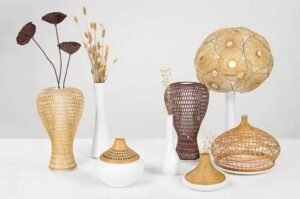Bamboo handicrafts have been captivating the hearts and minds of people around the world for centuries. With their natural beauty, durability, and versatility, these unique creations offer a glimpse into the rich cultural heritage and craftsmanship of different regions. In this article, we will explore the fascinating world of bamboo handicrafts, from their history and traditional techniques to their modern applications and environmental benefits.

I. Introduction to Bamboo Handicrafts
Bamboo is a remarkable material that has been used for centuries to create a wide variety of handicrafts. From baskets and mats to furniture and decorative items, bamboo handicrafts are known for their elegance, simplicity, and functionality. These crafts are often made by skilled artisans who use traditional techniques passed down through generations.
II. The History of Bamboo Handicrafts
Bamboo handicrafts have a long and storied history. In ancient times, bamboo was widely used in Asia for building materials, tools, and household items. Over time, bamboo crafts evolved and became more refined, reflecting the cultural and artistic traditions of different regions. Today, bamboo handicrafts are still highly regarded for their beauty and craftsmanship.
III. Types of Bamboo Handicrafts
There are many different types of bamboo handicrafts, including:
- Baskets: Bamboo baskets come in a variety of shapes and sizes, and are used for storage, transportation, and decoration.
- Mats: Bamboo mats are popular for use in homes and offices, providing a cool and comfortable surface.
- Furniture: Bamboo furniture is known for its durability and unique design.
- Decorative Items: From wall hangings to sculptures, bamboo decorative items add a touch of natural beauty to any space.
- Kitchenware: Bamboo kitchenware, such as cutting boards and utensils, is eco-friendly and practical.
- Jewelry: Bamboo jewelry is a unique and sustainable alternative to traditional materials.
- Toys: Bamboo toys are safe and durable for children.
- Garden Accessories: Bamboo garden accessories, such as trellises and planters, add a natural element to outdoor spaces.

IV. Traditional Bamboo Crafting Techniques
The creation of bamboo handicrafts often involves traditional techniques that have been passed down through generations. Some of these techniques include:
- Weaving: Bamboo strips are woven together to create baskets, mats, and other items.
- Carving: Skilled artisans use knives and other tools to carve intricate designs into bamboo.
- Bending: Bamboo can be bent and shaped using heat and pressure.
- Lacquering: Bamboo handicrafts are often coated with lacquer to protect them and enhance their beauty.
- Dyeing: Bamboo can be dyed using natural dyes to create a variety of colors.
V. Modern Applications of Bamboo Handicrafts
In addition to their traditional uses, bamboo handicrafts are also finding new applications in modern design and decor. Some of these include:
- Interior Design: Bamboo handicrafts can be used to add a natural and organic touch to interior spaces.
- Event Decor: Bamboo decorations are popular for weddings, parties, and other events.
- Sustainable Fashion: Bamboo fabric and accessories are becoming increasingly popular in the fashion industry.
- Corporate Gifts: Bamboo handicrafts make unique and eco-friendly corporate gifts.
- Tourist Souvenirs: Bamboo handicrafts are often purchased as souvenirs by tourists visiting different regions.
VI. The Environmental Benefits of Bamboo Handicrafts
Bamboo is a highly sustainable material, making bamboo handicrafts an environmentally friendly choice. Some of the environmental benefits of bamboo include:
- Fast Growth: Bamboo is one of the fastest-growing plants in the world, making it a renewable resource.
- Carbon Sequestration: Bamboo absorbs carbon dioxide from the atmosphere, helping to reduce greenhouse gas emissions.
- Soil Conservation: Bamboo roots help to stabilize soil and prevent erosion.
- Low Impact Harvesting: Bamboo can be harvested without causing significant damage to the environment.
- Biodegradable: Bamboo handicrafts are biodegradable, reducing waste and environmental impact.
VII. Where to Find Bamboo Handicrafts
There are many places where you can find bamboo handicrafts. Some options include:
- Local Markets: Visit local markets in areas where bamboo is abundant to find unique handicrafts.
- Online Retailers: There are many online retailers that specialize in bamboo handicrafts.
- Artisan Fairs: Attend artisan fairs and exhibitions to discover the work of talented bamboo craftsmen.
- Tourist Destinations: Many tourist destinations offer bamboo handicrafts as souvenirs.
- Direct from Artisans: Some artisans sell their handicrafts directly to customers through their own websites or social media channels.
VIII. How to Choose Quality Bamboo Handicrafts
When choosing bamboo handicrafts, it’s important to look for quality and durability. Some tips for choosing quality bamboo handicrafts include:
- Check the Craftsmanship: Look for handicrafts that are well-made and have tight weaves or smooth finishes.
- Inspect the Material: Make sure the bamboo is of high quality and free from cracks or defects.
- Consider the Design: Choose handicrafts that have unique and appealing designs.
- Read Reviews: Check online reviews to see what other customers have said about the quality of the handicrafts.
- Buy from Reputable Sellers: Purchase bamboo handicrafts from reputable sellers who stand behind their products.
IX. Caring for Bamboo Handicrafts
To ensure the longevity of your bamboo handicrafts, it’s important to take proper care of them. Some tips for caring for bamboo handicrafts include:
- Keep Dry: Avoid exposing bamboo handicrafts to excessive moisture, as this can cause them to warp or rot.
- Clean Regularly: Wipe bamboo handicrafts with a damp cloth to remove dust and dirt.
- Avoid Direct Sunlight: Keep bamboo handicrafts out of direct sunlight, as this can cause the color to fade.
- Store Properly: When not in use, store bamboo handicrafts in a dry and cool place.
- Handle with Care: Handle bamboo handicrafts gently to avoid damaging them.
X. Bamboo Handicrafts as Gifts
Bamboo handicrafts make excellent gifts for a variety of occasions. Some ideas for giving bamboo handicrafts as gifts include:
- Weddings: Bamboo baskets or decorative items make unique wedding gifts.
- Birthdays: Bamboo jewelry or kitchenware can be a thoughtful birthday gift.
- Housewarmings: Bamboo furniture or home decor items are perfect for housewarming parties.
- Corporate Gifts: Bamboo handicrafts make professional and eco-friendly corporate gifts.
- Festivals: Give bamboo handicrafts as gifts during festivals and holidays.
XI. The Cultural Significance of Bamboo Handicrafts
Bamboo handicrafts often hold cultural significance in different regions. They may be associated with specific traditions, rituals, or festivals. By purchasing and appreciating bamboo handicrafts, you can help to preserve and promote these cultural traditions.
XII. Bamboo Handicrafts and Sustainable Living
Bamboo handicrafts are a great way to incorporate sustainable living principles into your life. By choosing eco-friendly products made from renewable materials, you can reduce your environmental impact and support sustainable development.
XIII. The Future of Bamboo Handicrafts
As more people become aware of the environmental benefits of bamboo and the beauty of handmade crafts, the future of bamboo handicrafts looks bright. We can expect to see continued innovation and growth in this field, as artisans explore new techniques and designs.
XIV. Conclusion
Bamboo handicrafts are a beautiful and sustainable choice for home decor, gifts, and everyday use. With their natural beauty, durability, and versatility, these unique creations offer a glimpse into the rich cultural heritage and craftsmanship of different regions. By choosing bamboo handicrafts, you can support local artisans, reduce your environmental impact, and add a touch of natural elegance to your life.
XV. Call to Action
If you’re interested in bamboo handicrafts, consider purchasing some for yourself or as gifts. You can find a wide variety of bamboo handicrafts at local markets, online retailers, and artisan fairs. By supporting the artisans who create these beautiful products, you can help to preserve and promote this important cultural heritage.
XVI. FAQs about Bamboo Handicrafts
-
Are bamboo handicrafts durable?
Yes, bamboo handicrafts are known for their durability. When properly cared for, they can last for many years. -
Are bamboo handicrafts eco-friendly?
Yes, bamboo is a highly sustainable material, making bamboo handicrafts an environmentally friendly choice. -
Where can I find bamboo handicrafts?
You can find bamboo handicrafts at local markets, online retailers, artisan fairs, tourist destinations, and directly from artisans. -
How do I care for bamboo handicrafts?
To care for bamboo handicrafts, keep them dry, clean them regularly, avoid direct sunlight, store them properly, and handle them with care. -
What types of bamboo handicrafts are available?
There are many different types of bamboo handicrafts, including baskets, mats, furniture, decorative items, kitchenware, jewelry, toys, and garden accessories.

Leave a Reply